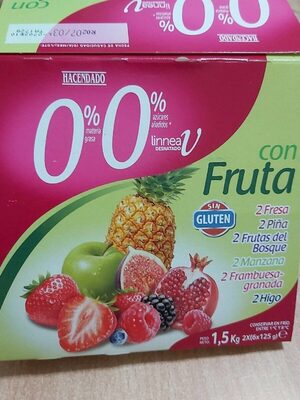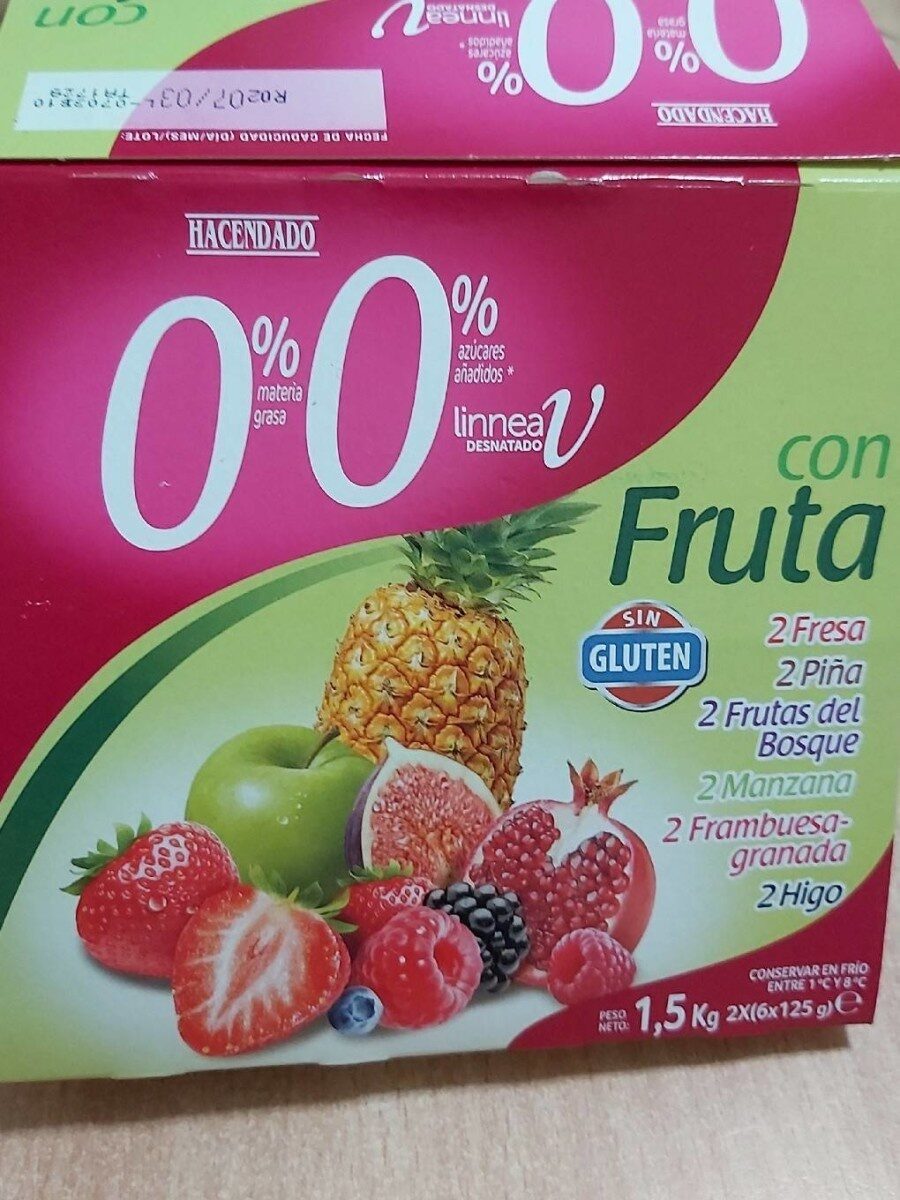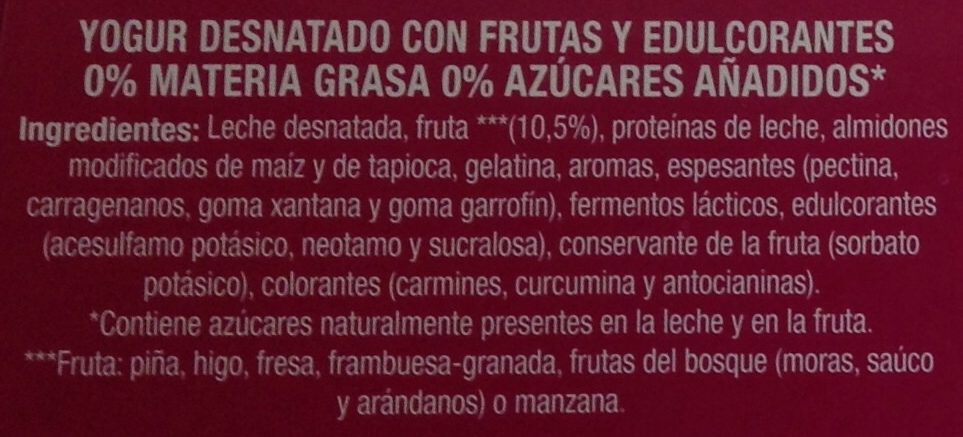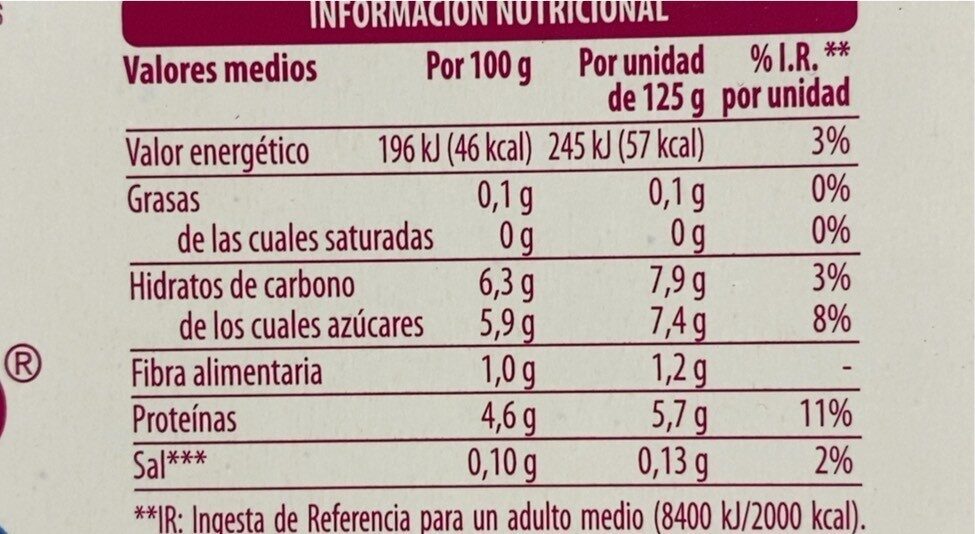Help us make food transparency the norm!
As a non-profit organization, we depend on your donations to continue informing consumers around the world about what they eat.
The food revolution starts with you!
Yogurt 0%con fruta - Hacendado - 1,5 kg (12 * 125 g)
Yogurt 0%con fruta - Hacendado - 1,5 kg (12 * 125 g)
This product page is not complete. You can help to complete it by editing it and adding more data from the photos we have, or by taking more photos using the app for Android or iPhone/iPad. Thank you!
×
Barra-kodea: 8480000203151 (EAN / EAN-13)
Izen arrunta: Yogur desnatado con frutas y edulcorantes 0% materia grasa 0% azúcares añadidos
Kopurua: 1,5 kg (12 * 125 g)
Ontziratzea: en:Plastic, en:container, en:Fresh
Markak: Hacendado
Kategoriak: Esneki, en:Fermented foods, en:Fermented milk products, en:Desserts, en:Dairy desserts, en:Fermented dairy desserts, en:Fermented dairy desserts with fruits, Jogurt, en:Fruit yogurts, en:Apple yogurts, en:Pineapple yogurts, en:Raspberry yogurts, en:Strawberry yogurts
Etiketak, ziurtagiriak, sariak:
en:Low or no fat, en:No gluten, en:Green Dot, No added sugar, No fat, en:With sweeteners
Manufacturing or processing places: España, Francia
Traceability code: ES 15.04549/TO CE, FR 57.132.001 CE - Château-Salins (Moselle, France), FR 89.209.001 CE - Jouy (Yonne, France)
Saltzen diren herrialdeak: Espainia
Matching with your preferences
Health
Osagaiak
-
23 ingredients
Gaztelania: Leche desnatada, fruta, proteínas de leche, almidones modificados de maíz y de tapioca, gelatina, aromas, espesantes (pectina, carragenanos, goma xantana, goma garrofin), fermentos lácticos, edulcorantes (acesulfamo potásico, neotamo, sucralosa), conservante de la fruta (sorbato potásico), colorantes (carmines, curcumina, antocianinas).Alergenoak: en:Milk
Food processing
-
Ultra processed foods
Elements that indicate the product is in the 4 - Ultra prozesatutako elikagaiak eta edariak group:
- Gehigarria: E100
- Gehigarria: E120 - Gorrimin
- Gehigarria: E163 - Antozianina
- Gehigarria: E407
- Gehigarria: E410 - Algarrobo-goma
- Gehigarria: E415
- Gehigarria: E428 - Gelatina
- Gehigarria: E440 - Pektina
- Gehigarria: E950
- Gehigarria: E955
- Gehigarria: E961
- Osagaia: Colour
- Osagaia: Flavouring
- Osagaia: Milk proteins
- Osagaia: Sweetener
- Osagaia: Thickener
Food products are classified into 4 groups according to their degree of processing:
- Prozesatu gabeko edo ahalik eta gutxien prozesatutako elikagaiak
- Sukaldaritzako osagaiak prozesatu
- Prozesatutako jakiak
- Ultra processed foods
The determination of the group is based on the category of the product and on the ingredients it contains.
Gehigarriak
-
E120 - Gorrimin
Carminic acid: Carminic acid -C22H20O13- is a red glucosidal hydroxyanthrapurin that occurs naturally in some scale insects, such as the cochineal, Armenian cochineal, and Polish cochineal. The insects produce the acid as a deterrent to predators. An aluminum salt of carminic acid is the coloring agent in carmine. Synonyms are C.I. 75470 and C.I. Natural Red 4. The chemical structure of carminic acid consists of a core anthraquinone structure linked to a glucose sugar unit. Carminic acid was first synthesized in the laboratory by organic chemists in 1991.Source: Wikipedia (Ingeles)
-
E163 - Antozianina
Anthocyanin: Anthocyanins -also anthocyans; from Greek: ἄνθος -anthos- "flower" and κυάνεος/κυανοῦς kyaneos/kyanous "dark blue"- are water-soluble vacuolar pigments that, depending on their pH, may appear red, purple, or blue. Food plants rich in anthocyanins include the blueberry, raspberry, black rice, and black soybean, among many others that are red, blue, purple, or black. Some of the colors of autumn leaves are derived from anthocyanins.Anthocyanins belong to a parent class of molecules called flavonoids synthesized via the phenylpropanoid pathway. They occur in all tissues of higher plants, including leaves, stems, roots, flowers, and fruits. Anthocyanins are derived from anthocyanidins by adding sugars. They are odorless and moderately astringent. Although approved to color foods and beverages in the European Union, anthocyanins are not approved for use as a food additive because they have not been verified as safe when used as food or supplement ingredients. There is no conclusive evidence anthocyanins have any effect on human biology or diseases.Source: Wikipedia (Ingeles)
-
E202
Potassium sorbate: Potassium sorbate is the potassium salt of sorbic acid, chemical formula CH3CH=CH−CH=CH−CO2K. It is a white salt that is very soluble in water -58.2% at 20 °C-. It is primarily used as a food preservative -E number 202-. Potassium sorbate is effective in a variety of applications including food, wine, and personal-care products. While sorbic acid is naturally occurring in some berries, virtually all of the world's production of sorbic acid, from which potassium sorbate is derived, is manufactured synthetically.Source: Wikipedia (Ingeles)
-
E407
Carrageenan: Carrageenans or carrageenins - karr-ə-gee-nənz, from Irish carraigín, "little rock"- are a family of linear sulfated polysaccharides that are extracted from red edible seaweeds. They are widely used in the food industry, for their gelling, thickening, and stabilizing properties. Their main application is in dairy and meat products, due to their strong binding to food proteins. There are three main varieties of carrageenan, which differ in their degree of sulfation. Kappa-carrageenan has one sulfate group per disaccharide, iota-carrageenan has two, and lambda-carrageenan has three. Gelatinous extracts of the Chondrus crispus -Irish moss- seaweed have been used as food additives since approximately the fifteenth century. Carrageenan is a vegetarian and vegan alternative to gelatin in some applications or may be used to replace gelatin in confectionery.Source: Wikipedia (Ingeles)
-
E410 - Algarrobo-goma
Locust bean gum: Locust bean gum -LBG, also known as carob gum, carob bean gum, carobin, E410- is a thickening agent and a gelling agent used in food technology.Source: Wikipedia (Ingeles)
-
E415
Xanthan gum: Xanthan gum -- is a polysaccharide with many industrial uses, including as a common food additive. It is an effective thickening agent and stabilizer to prevent ingredients from separating. It can be produced from simple sugars using a fermentation process, and derives its name from the species of bacteria used, Xanthomonas campestris.Source: Wikipedia (Ingeles)
-
E440 - Pektina
Pectin: Pectin -from Ancient Greek: πηκτικός pēktikós, "congealed, curdled"- is a structural heteropolysaccharide contained in the primary cell walls of terrestrial plants. It was first isolated and described in 1825 by Henri Braconnot. It is produced commercially as a white to light brown powder, mainly extracted from citrus fruits, and is used in food as a gelling agent, particularly in jams and jellies. It is also used in dessert fillings, medicines, sweets, as a stabilizer in fruit juices and milk drinks, and as a source of dietary fiber.Source: Wikipedia (Ingeles)
-
E950
Acesulfame potassium: Acesulfame potassium - AY-see-SUL-faym-, also known as acesulfame K -K is the symbol for potassium- or Ace K, is a calorie-free sugar substitute -artificial sweetener- often marketed under the trade names Sunett and Sweet One. In the European Union, it is known under the E number -additive code- E950. It was discovered accidentally in 1967 by German chemist Karl Clauss at Hoechst AG -now Nutrinova-. In chemical structure, acesulfame potassium is the potassium salt of 6-methyl-1‚2,3-oxathiazine-4-3H--one 2‚2-dioxide. It is a white crystalline powder with molecular formula C4H4KNO4S and a molecular weight of 201.24 g/mol.Source: Wikipedia (Ingeles)
-
E955
Sucralose: Sucralose is an artificial sweetener and sugar substitute. The majority of ingested sucralose is not broken down by the body, so it is noncaloric. In the European Union, it is also known under the E number E955. It is produced by chlorination of sucrose. Sucralose is about 320 to 1‚000 times sweeter than sucrose, three times as sweet as both aspartame and acesulfame potassium, and twice as sweet as sodium saccharin. Evidence of benefit is lacking for long-term weight loss with some data supporting weight gain and heart disease risks.It is stable under heat and over a broad range of pH conditions. Therefore, it can be used in baking or in products that require a long shelf life. The commercial success of sucralose-based products stems from its favorable comparison to other low-calorie sweeteners in terms of taste, stability, and safety. Common brand names of sucralose-based sweeteners are Splenda, Zerocal, Sukrana, SucraPlus, Candys, Cukren, and Nevella. Canderel Yellow also contains sucralose, but the original Canderel and Green Canderel do not.Source: Wikipedia (Ingeles)
-
E961
Neotame: Neotame is an artificial sweetener made by NutraSweet that is between 7‚000 and 13‚000 times sweeter than sucrose -table sugar-. In the European Union, it is known by the E number E961. It is moderately heat-stable, extremely potent, rapidly metabolized, completely eliminated, and does not appear to accumulate in the body.The major metabolic pathway is hydrolysis of the methyl ester by esterases that are present throughout the body, which yields de-esterified neotame and methanol. Because only trace amounts of neotame are needed to sweeten foods, the amount of methanol derived from neotame is much lower than that found in common foods.The product is attractive to food manufacturers, as its use greatly lowers the cost of production compared to using sugar or high fructose corn syrup -due to the lower quantities needed to achieve the same sweetening-, while also benefitting the consumer by providing fewer "empty" sugar calories and a lower impact on blood sugar.Source: Wikipedia (Ingeles)
Ingredients analysis
-
en:Palm oil free
No ingredients containing palm oil detected
Unrecognized ingredients: es:conservante-de-la-frutaSome ingredients could not be recognized.
We need your help!
You can help us recognize more ingredients and better analyze the list of ingredients for this product and others:
- Edit this product page to correct spelling mistakes in the ingredients list, and/or to remove ingredients in other languages and sentences that are not related to the ingredients.
- Add new entries, synonyms or translations to our multilingual lists of ingredients, ingredient processing methods, and labels.
If you would like to help, join the #ingredients channel on our Slack discussion space and/or learn about ingredients analysis on our wiki. Thank you!
-
en:Non-vegan
Non-vegan ingredients: en:Skimmed milk, en:Milk proteins, E428, E120Some ingredients could not be recognized.
We need your help!
You can help us recognize more ingredients and better analyze the list of ingredients for this product and others:
- Edit this product page to correct spelling mistakes in the ingredients list, and/or to remove ingredients in other languages and sentences that are not related to the ingredients.
- Add new entries, synonyms or translations to our multilingual lists of ingredients, ingredient processing methods, and labels.
If you would like to help, join the #ingredients channel on our Slack discussion space and/or learn about ingredients analysis on our wiki. Thank you!
-
en:Non-vegetarian
Non-vegetarian ingredients: E428, E120Some ingredients could not be recognized.
We need your help!
You can help us recognize more ingredients and better analyze the list of ingredients for this product and others:
- Edit this product page to correct spelling mistakes in the ingredients list, and/or to remove ingredients in other languages and sentences that are not related to the ingredients.
- Add new entries, synonyms or translations to our multilingual lists of ingredients, ingredient processing methods, and labels.
If you would like to help, join the #ingredients channel on our Slack discussion space and/or learn about ingredients analysis on our wiki. Thank you!
-
Details of the analysis of the ingredients
We need your help!
Some ingredients could not be recognized.
We need your help!
You can help us recognize more ingredients and better analyze the list of ingredients for this product and others:
- Edit this product page to correct spelling mistakes in the ingredients list, and/or to remove ingredients in other languages and sentences that are not related to the ingredients.
- Add new entries, synonyms or translations to our multilingual lists of ingredients, ingredient processing methods, and labels.
If you would like to help, join the #ingredients channel on our Slack discussion space and/or learn about ingredients analysis on our wiki. Thank you!
es: Leche desnatada, fruta, proteínas de leche, almidones modificados de maíz, de tapioca, gelatina, aromas, espesantes (pectina, carragenanos, goma xantana, goma garrofin), fermentos lácticos, edulcorantes (acesulfamo potásico, neotamo, sucralosa), conservante de la fruta (sorbato potásico), colorantes (carmines, curcumina, antocianinas)- Leche desnatada -> en:skimmed-milk - vegan: no - vegetarian: yes - ciqual_proxy_food_code: 19051 - percent_min: 8.33333333333333 - percent_max: 100
- fruta -> en:fruit - vegan: yes - vegetarian: yes - percent_min: 0 - percent_max: 50
- proteínas de leche -> en:milk-proteins - vegan: no - vegetarian: yes - percent_min: 0 - percent_max: 33.3333333333333
- almidones modificados de maíz -> en:modified-corn-starch - vegan: yes - vegetarian: yes - ciqual_food_code: 9510 - percent_min: 0 - percent_max: 25
- de tapioca -> en:tapioca - vegan: yes - vegetarian: yes - ciqual_proxy_food_code: 9510 - percent_min: 0 - percent_max: 20
- gelatina -> en:e428 - vegan: no - vegetarian: no - percent_min: 0 - percent_max: 16.6666666666667
- aromas -> en:flavouring - vegan: maybe - vegetarian: maybe - percent_min: 0 - percent_max: 5
- espesantes -> en:thickener - percent_min: 0 - percent_max: 5
- pectina -> en:e440a - vegan: yes - vegetarian: yes - percent_min: 0 - percent_max: 5
- carragenanos -> en:e407 - vegan: yes - vegetarian: yes - percent_min: 0 - percent_max: 2.5
- goma xantana -> en:e415 - vegan: yes - vegetarian: yes - percent_min: 0 - percent_max: 1.66666666666667
- goma garrofin -> en:e410 - vegan: yes - vegetarian: yes - percent_min: 0 - percent_max: 1.25
- fermentos lácticos -> en:lactic-ferments - vegan: maybe - vegetarian: yes - percent_min: 0 - percent_max: 5
- edulcorantes -> en:sweetener - percent_min: 0 - percent_max: 5
- acesulfamo potásico -> en:e950 - vegan: yes - vegetarian: yes - percent_min: 0 - percent_max: 5
- neotamo -> en:e961 - vegan: yes - vegetarian: yes - percent_min: 0 - percent_max: 2.5
- sucralosa -> en:e955 - vegan: yes - vegetarian: yes - percent_min: 0 - percent_max: 1.66666666666667
- conservante de la fruta -> es:conservante-de-la-fruta - percent_min: 0 - percent_max: 5
- sorbato potásico -> en:e202 - vegan: yes - vegetarian: yes - percent_min: 0 - percent_max: 5
- colorantes -> en:colour - percent_min: 0 - percent_max: 5
- carmines -> en:e120 - vegan: no - vegetarian: no - percent_min: 0 - percent_max: 5
- curcumina -> en:e100 - vegan: yes - vegetarian: yes - percent_min: 0 - percent_max: 2.5
- antocianinas -> en:e163 - vegan: yes - vegetarian: yes - percent_min: 0 - percent_max: 1.66666666666667
Elikadura
-
Nutrizio-kalitate oso ona
⚠ ️Warning: the amount of fruits, vegetables and nuts is not specified on the label, it was manually estimated from the list of ingredients: 10This product is not considered a beverage for the calculation of the Nutri-Score.
Positive points: 3
- Proteinak: 2 / 5 (balioa: 4.6, rounded value: 4.6)
- Fiber: 1 / 5 (balioa: 1, rounded value: 1)
- Fruits, vegetables, nuts, and colza/walnut/olive oils: 0 / 5 (balioa: 10.5, rounded value: 10.5)
Negative points: 1
- Energia: 0 / 10 (balioa: 196, rounded value: 196)
- Azukreak: 1 / 10 (balioa: 5.9, rounded value: 5.9)
- Gantz saturatua: 0 / 10 (balioa: 0, rounded value: 0)
- Sodioa: 0 / 10 (balioa: 40, rounded value: 40)
The points for proteins are counted because the negative points are less than 11.
Nutritional score: (1 - 3)
Nutri-Score:
-
Nutrient levels
-
Koipe in low quantity (0.1%)
What you need to know- A high consumption of fat, especially saturated fats, can raise cholesterol, which increases the risk of heart diseases.
Recommendation: Limit the consumption of fat and saturated fat- Choose products with lower fat and saturated fat content.
-
Gantz-azido ase in low quantity (0%)
What you need to know- A high consumption of fat, especially saturated fats, can raise cholesterol, which increases the risk of heart diseases.
Recommendation: Limit the consumption of fat and saturated fat- Choose products with lower fat and saturated fat content.
-
Azukre in moderate quantity (5.9%)
What you need to know- A high consumption of sugar can cause weight gain and tooth decay. It also augments the risk of type 2 diabetes and cardio-vascular diseases.
Recommendation: Limit the consumption of sugar and sugary drinks- Sugary drinks (such as sodas, fruit beverages, and fruit juices and nectars) should be limited as much as possible (no more than 1 glass a day).
- Choose products with lower sugar content and reduce the consumption of products with added sugars.
-
Gatz arrunt in low quantity (0.1%)
What you need to know- A high consumption of salt (or sodium) can cause raised blood pressure, which can increase the risk of heart disease and stroke.
- Many people who have high blood pressure do not know it, as there are often no symptoms.
- Most people consume too much salt (on average 9 to 12 grams per day), around twice the recommended maximum level of intake.
Recommendation: Limit the consumption of salt and salted food- Reduce the quantity of salt used when cooking, and don't salt again at the table.
- Limit the consumption of salty snacks and choose products with lower salt content.
-
-
Nutrition facts
Nutrition facts As sold
for 100 g / 100 mlAs sold
per serving (125 g)Compared to: en:Pineapple yogurts Energia 196 kj
(46 kcal)245 kj
(57 kcal)-% 17 Koipe 0,1 g 0,125 g -% 83 Gantz-azido ase 0 g 0 g -% 100 Carbohydrates 6,3 g 7,88 g -% 24 Azukre 5,9 g 7,38 g -% 24 Fiber 1 g 1,25 g Proteina 4,6 g 5,75 g +% 10 Gatz arrunt 0,1 g 0,125 g -% 17 Kaltzio 120 mg 150 mg Fruits‚ vegetables‚ nuts and rapeseed‚ walnut and olive oils (manual estimate from ingredients list) 10,5 % 10,5 % Fruits‚ vegetables‚ nuts and rapeseed‚ walnut and olive oils (estimate from ingredients list analysis) 22,917 % 22,917 %
Ingurumena
-
Eco-Score B - Ingurumen-eragin txikia
The Eco-Score is an experimental score that summarizes the environmental impacts of food products.→ The Eco-Score was initially developped for France and it is being extended to other European countries. The Eco-Score formula is subject to change as it is regularly improved to make it more precise and better suited to each country.Life cycle analysis
-
Average impact of products of the same category: A (Score: 83/100)
Kategoria: Yogurt, fermented milk or dairy specialty, with fruits, with sugar, fortified with vitamin D
Kategoria: Yogurt, fermented milk or dairy specialty, with fruits, with sugar, fortified with vitamin D
- PEF environmental score: 0.25 (the lower the score, the lower the impact)
- including impact on climate change: 2.14 kg CO2 eq/kg of product
Stage Impact Agriculture
70.4 %Processing
11.8 %Ontziratzea
6.0 %Transportation
7.4 %Distribution
3.5 %Consumption
1.0 %
Bonuses and maluses
-
Missing origins of ingredients information
Malus: -5
⚠ ️ The origins of the ingredients of this product are not indicated.
If they are indicated on the packaging, you can modify the product sheet and add them.
If you are the manufacturer of this product, you can send us the information with our free platform for producers.
-
Packaging with a medium impact
Malus: -10
Shape Material Recycling Impact Unknown Plastic Altua ⚠ ️ The information about the packaging of this product is not sufficiently precise (exact shapes and materials of all components of the packaging).⚠ ️ For a more precise calculation of the Eco-Score, you can modify the product page and add them.
If you are the manufacturer of this product, you can send us the information with our free platform for producers.
Eco-Score for this product
-
Impact for this product: B (Score: 68/100)
Produktua: Yogurt 0%con fruta - Hacendado - 1,5 kg (12 * 125 g)
Life cycle analysis score: 83
Sum of bonuses and maluses: -15
Final score: 68/100
-
Carbon footprint
-
Equal to driving 1.1 km in a petrol car
214 g CO² per 100g of product
The carbon emission figure comes from ADEME's Agribalyse database, for the category: Yogurt, fermented milk or dairy specialty, with fruits, with sugar, fortified with vitamin D (Source: ADEME Agribalyse Database)
Stage Impact Agriculture
71.6 %Processing
7.0 %Ontziratzea
8.4 %Transportation
11.1 %Distribution
1.7 %Consumption
0.3 %
Ontziratzea
-
Packaging with a medium impact
-
Packaging parts
(Plastic)
-
Bilgarriaren materialak
Material % Bilgarriaren pisua Bilgarriaren pisua produktuaren 100g-ko Plastic
-
Transportation
-
Origins of ingredients
Missing origins of ingredients information
⚠ ️ The origins of the ingredients of this product are not indicated.
If they are indicated on the packaging, you can modify the product sheet and add them.
If you are the manufacturer of this product, you can send us the information with our free platform for producers.Add the origins of ingredients for this product Add the origins of ingredients for this product
Report a problem
-
Incomplete or incorrect information?
Category, labels, ingredients, allergens, nutritional information, photos etc.
If the information does not match the information on the packaging, please complete or correct it. Open Food Facts is a collaborative database, and every contribution is useful for all.
Datuen iturria
Product added on by malikele
Last edit of product page on by 5m4u9.
Produktuaren orria -gatik editatua benbenben, beniben, ecoscore-impact-estimator, kiliweb, maylord, musarana, openfoodfacts-contributors, packbot, roboto-app, saisa, tacite-mass-editor, thaialagata, yuka.WjZJZVFZTU52cUFYaGNBejhDck53ZlZFNWFPUmJYenZLdkFPSVE9PQ, yuka.WmIwdUNZdFFwL3dXcS9FQm9VK0twUFlweDQrcEFGenZKc0ZNSVE9PQ, yuka.sY2b0xO6T85zoF3NwEKvlkMbbOTSqTzNaRPliGC6xvygDZHoRe9776nDKqg, yuka.sY2b0xO6T85zoF3NwEKvlkZEc_iHkDXDBy3RvHSk-NHUCLDTT8Ap-KSrGqo, yuka.sY2b0xO6T85zoF3NwEKvlkhEXMPBjRj8HT_mhEOh_s2DfozYfe9j2rHHNqs.










